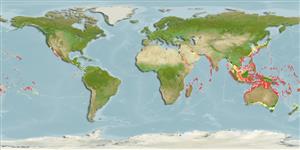Environment: milieu / climate zone / εύρος βάθους / distribution range
Οικολογία
Θαλασσινό(ά) Υφαλόφιλο(α); εύρος βάθους 0 - 55 m (Ref. 90102). Tropical
Indo-West Pacific: East Africa to Micronesia, Line Islands, and Society Islands, and Taiwan to Australia (Ref. 90102); including Papua New Guinea, Line Islands and Society Islands; Taiwan to reefs of Coral Sea and New Caledonia (Ref. 54980).
Μέγεθος / Βάρος / Age
Γεννητική Ωρίμανση: Lm ? range ? - ? cm
Max length : 4.0 cm TL αρσενικό/απροσδιόριστο; (Ref. 48636)
Short description
Κλείδες προσδιορισμού | Μορφολογία | Μορφομετρία
Ραχιαίες άκανθες (συνολικά) : 13 - 16; Μαλακές ραχιαίες ακτίνες (συνολικά) : 7 - 10; Εδρικές άκανθες: 1; Μαλακές εδρικές ακτίνες: 15 - 20. Identified by the tall first dorsal fin that is white in males (Ref. 48636). Large individuals may have conspicuous dark spot on upper middle of second dorsal fin connected to a band extending down the sides as well as about 5 darker bars on body and red snout and lower head (Ref. 37816).
Body shape (shape guide): elongated.
Adults are found in various reef habitats, but often on sponges or reef outcrops (Ref. 48636). Also found in intertidal pools (Ref. 13227) and on corals and rocks (Ref. 37816). They feed on zooplankton (Ref. 48636). Eggs are hemispherical and covered with numerous sticky threads that anchor them in the algae on the nesting sites (Ref. 240). Larvae are planktonic which occur primarily in shallow, nearshore waters (Ref. 94114). The most common and most widely distributed among Enneapterygius species (Ref. 90102). Minimum depth reported from Ref. 13227.
Life cycle and mating behavior
Γεννητική Ωρίμανση | Αναπαραγωγή | Γεννοβολία | Αβγά | Γονιμότητα | Προνύμφες
Fricke, R., 1994. Tripterygiid fishes of Australia, New Zealand and the southwest Pacific Ocean (Teleostei). Theses Zool. 24:1-585. (Ref. 13227)
IUCN Red List Status (Ref. 130435: Version 2025-1)
Threat to humans
Harmless
Human uses
αλιεία: χωρίς ενδιαφέρον
Εργαλεία
Special reports
Download XML
Διαδικτυακές πηγές
Estimates based on models
Preferred temperature (Αναφ.
123201): 24.1 - 28.9, mean 27.5 °C (based on 802 cells).
Phylogenetic diversity index (Αναφ.
82804): PD
50 = 0.5000 [Uniqueness, from 0.5 = low to 2.0 = high].
Bayesian length-weight: a=0.00617 (0.00288 - 0.01322), b=3.04 (2.86 - 3.22), in cm total length, based on LWR estimates for this (Sub)family-body shape (Ref.
93245).
Τροφικό Επίπεδο (Αναφ.
69278): 3.4 ±0.45 se; based on food items.
Ελαστικότητα (Αναφ.
120179): Υψηλό, ελάχιστος χρόνος για διπλασιασμό πληθυσμού < 15 μήνες (Preliminary K or Fecundity.).
Fishing Vulnerability (Ref.
59153): Low vulnerability (10 of 100).
🛈
Nutrients (Ref.
124155): Calcium = 433 [156, 1,848] mg/100g; Iron = 2.47 [0.83, 5.79] mg/100g; Protein = 18.1 [16.2, 19.9] %; Omega3 = 0.108 [0.024, 0.510] g/100g; Selenium = 89.7 [15.6, 432.6] μg/100g; VitaminA = 35 [4, 270] μg/100g; Zinc = 5.59 [2.35, 10.78] mg/100g (wet weight);
